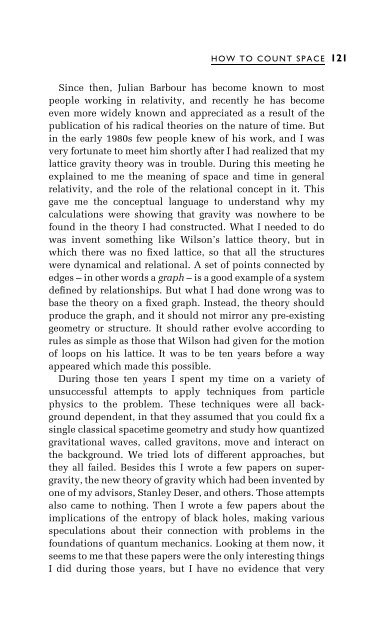Three Roads To Quantum Gravity
Three Roads To Quantum Gravity
Three Roads To Quantum Gravity
You also want an ePaper? Increase the reach of your titles
YUMPU automatically turns print PDFs into web optimized ePapers that Google loves.
HOW TO COUNT SPACE<br />
121<br />
Since then, Julian Barbour has become known to most<br />
people working in relativity, and recently he has become<br />
even more widely known and appreciated as a result of the<br />
publication of his radical theories on the nature of time. But<br />
in the early 1980s few people knew of his work, and I was<br />
very fortunate to meet him shortly after I had realized that my<br />
lattice gravity theory was in trouble. During this meeting he<br />
explained to me the meaning of space and time in general<br />
relativity, and the role of the relational concept in it. This<br />
gave me the conceptual language to understand why my<br />
calculations were showing that gravity was nowhere to be<br />
found in the theory I had constructed. What I needed to do<br />
was invent something like Wilson's lattice theory, but in<br />
which there was no ®xed lattice, so that all the structures<br />
were dynamical and relational. A set of points connected by<br />
edges ± in other words a graph ± is a good example of a system<br />
de®ned by relationships. But what I had done wrong was to<br />
base the theory on a ®xed graph. Instead, the theory should<br />
produce the graph, and it should not mirror any pre-existing<br />
geometry or structure. It should rather evolve according to<br />
rules as simple as those that Wilson had given for the motion<br />
of loops on his lattice. It was to be ten years before a way<br />
appeared which made this possible.<br />
During those ten years I spent my time on a variety of<br />
unsuccessful attempts to apply techniques from particle<br />
physics to the problem. These techniques were all background<br />
dependent, in that they assumed that you could ®x a<br />
single classical spacetime geometry and study how quantized<br />
gravitational waves, called gravitons, move and interact on<br />
the background. We tried lots of different approaches, but<br />
they all failed. Besides this I wrote a few papers on supergravity,<br />
the new theory of gravity which had been invented by<br />
one of my advisors, Stanley Deser, and others. Those attempts<br />
also came to nothing. Then I wrote a few papers about the<br />
implications of the entropy of black holes, making various<br />
speculations about their connection with problems in the<br />
foundations of quantum mechanics. Looking at them now, it<br />
seems to me that these papers were the only interesting things<br />
I did during those years, but I have no evidence that very



![arXiv:1001.0993v1 [hep-ph] 6 Jan 2010](https://img.yumpu.com/51282177/1/190x245/arxiv10010993v1-hep-ph-6-jan-2010.jpg?quality=85)


![arXiv:1008.3907v2 [astro-ph.CO] 1 Nov 2011](https://img.yumpu.com/48909562/1/190x245/arxiv10083907v2-astro-phco-1-nov-2011.jpg?quality=85)








![arXiv:1002.4928v1 [gr-qc] 26 Feb 2010](https://img.yumpu.com/41209516/1/190x245/arxiv10024928v1-gr-qc-26-feb-2010.jpg?quality=85)
![arXiv:1206.2653v1 [astro-ph.CO] 12 Jun 2012](https://img.yumpu.com/39510078/1/190x245/arxiv12062653v1-astro-phco-12-jun-2012.jpg?quality=85)
